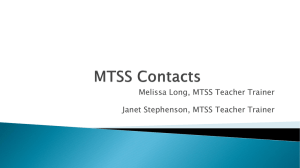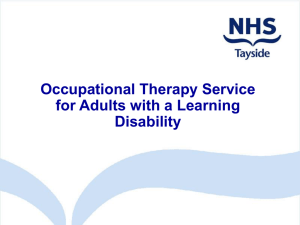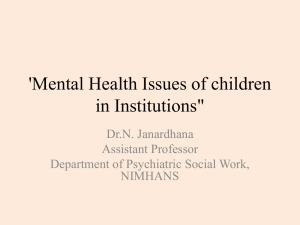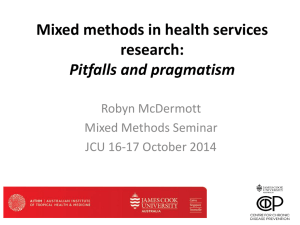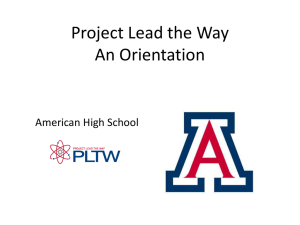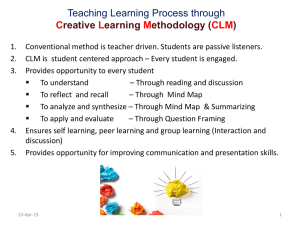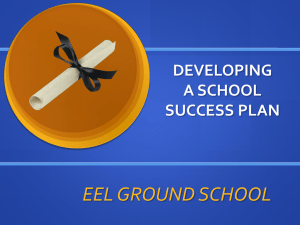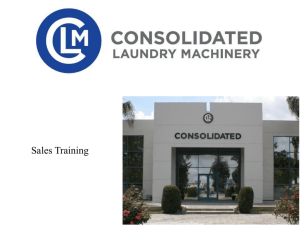A Model for Comprehensive Literacy Instruction
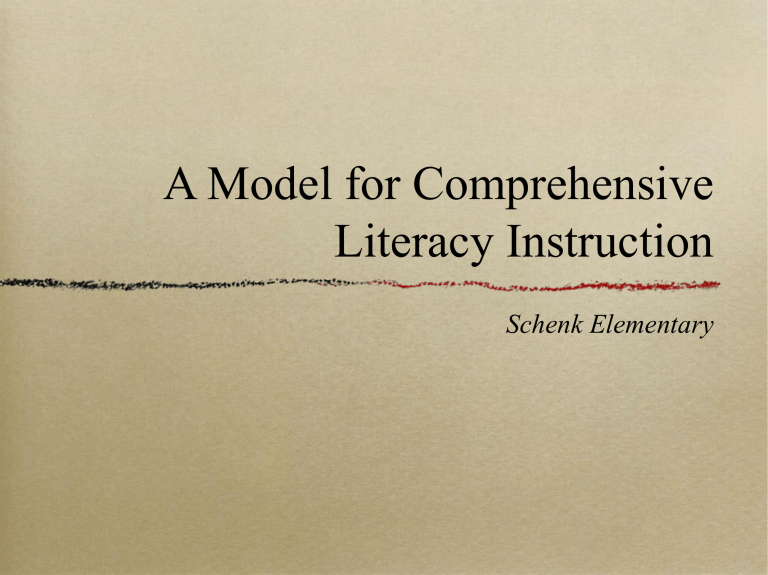
A Model for Comprehensive
Literacy Instruction
Schenk Elementary
Why we are moving in this direction
Not meeting all of our students needs...1/3 of our students
Significant gaps
Disabilities
ELL
Students of color
Regression after interventions
“If children are apparently unable to learn, we should assume that we have not as yet found the right way to teach them.”
-Marie Clay
From our beliefs...
We believe that it is our responsibility to reach all kids
We believe in Balanced Literacy
We know that Reading Recovery shows benefits, but they are not always sustained
What is missing?
Where is success happening?
The CLM supports our beliefs
Balanced Literacy
Vertical Alignment
Site based PD & coaching
Core is not enough
Clinical nature of systematic observation from RR
Layered 4-Tier Framework
Learning more about it
• Professional Reading
• School site visitations
• Washington Elementary in D.C. Everest School District
• Lincoln Elementary School in Shawano
•
Mountain Bay Elementary School in Westin
• Eisenhower Elementary School in Green Bay
• Conferences
• CIM in Little Rock, Arkansas; CLM in Pembine, WI
• ESAIL survey based upon the 10 criteria of their model
Synthesizing Our Big Ideas
•
We needed a school-wide systematic approach to address...
• Core is not enough
• Fidelity is essential
• Progress Monitoring Targets Instruction
Turn & Talk
Core is Not Enough
Past Practice
• Teachers differentiate by their own creative means
Some have received certain professional development while others have not
Systematic Thinking through
CLM
• Specific differentiation from a menu of choices
We will all continually receive professional development to add to our growing knowledge of how to do this
Core is Not Enough
Past Practice
• Our classroom interventions were creatively designed
• Dependent upon who you sought for more information...building team issue
Systematic Thinking through
CLM
• Specific Tier 1
Interventions from a menu of choices
• One to one conferences
• Specific Small Group
Interventions
Specific Tier 1 Small Group Interventions
•
Emergent Language & Literacy Group
•
Guided Reading Plus
•
Comprehension Focus Group
•
Assisted Writing Group
•
Writing Process Group
•
Oracy Group
•
Content Strategy Group
Specific Tier 1 Small Group Interventions
•
Emergent Language & Literacy Group
Guided Reading Plus
•
Comprehension Focus Group
•
Assisted Writing Group
•
Writing Process Group
•
Oracy Group
Content Strategy Group
Core is Not Enough
Past Practice
• Interventions beyond the classroom had become inconsistent
• Often not aligned with
Tier 1 Interventions and/or Core
Systematic Thinking through
CLM
• Must be receiving Tier 1
• Highly trained specialists deliver Tiers 2 & 3
• Specific interventions
Specific Interventions
Tier 2 (small groups)
Emergent Language & Literacy Group
Guided Reading Plus
Comprehension Focus Group
Assisted Writing Group
Writing Process Group
Oracy Group
Content Strategy Group
Specific Interventions
Tier 2 (small groups)
Tier 3 (1:1 or 1:2)
Emergent Language & Literacy Group
For students at the Emergent Level who are not in
Special Education
Guided Reading Plus
RR in Grade 1
Comprehension Focus Group
Reading or Writing Conferences in specific tailored interventions searching for acceleration
Assisted Writing Group
Writing Process Group
Oracy Group
Content Strategy Group
Tier 4 Interventions
Special Education Teacher delivers
Child must be receiving Core instruction as IEP deems appropriate
Intervention must align with Core
Turn & Talk
Fidelity is Essential
Past Practice
Systematic Thinking through CLM
• District level PD for Core (not attended by all)
• IRTs in buildings (not similar in background knowledge, not able to reach everyone)
• Intervention support not consistent
• Communication between Core teachers and between Interventionists not consistent or aligned
• 30 minute weekly GL PD led by IRT
• Horizontal & Vertical Alignment
• Coaching Cycles, Observation
• 2 hour weekly IS PD led by IRT
• Behind the Glass/Peer Observation
• Coaching & Problem Solving with IRT
• Whole Day/Once per month CC PD led by IRT
• Study/sharing of Literacy Processing
• Peer Observation, Coaching & Problem
Solving with IRT
Fidelity is Essential
Past Practice
Systematic Thinking through
CLM
• Use the state and district standards, as well as student assessments, to determine instructional content
• Often done either independently, classroom by classroom, OR, sometimes, grade level by grade level
• No consistent expectations throughout the school in regard to content or student educational practices
• Horizontal & vertical alignment of instructional practices, interventions and formative assessments
• Horizontal & Vertical alignment, K-5:
• Genres
• Comprehension Strategies
• Thoughtful Log & Rubric
• Progress Monitoring (formative
& summative)
Progress Monitoring Targets Instruction
Past Practice
• Screening: PLAA
• Diagnostic, formative assessments done at teacher discretion. Rarely shared. Random & not aligned.
• Progress Monitoring PLAA at Quarter 2 & 3
• Outcome, summative assessments: PLAA,
WKCE, ACCESS
Systematic Thinking through CLM
• Screening: PLAA
• Weekly GL PD meetings will include dialogue in regard to student progress and collaboratively designed formative assessments
• Progress Monitoring quarterly for the PMW using TRL & Thoughtful Log Rubric
• Weekly PM for Tier 2
• Daily for Tier 3
• Core teacher & Interventionist meet for at least 10 minutes every 2-3 weeks to discuss student progress
Progress Monitoring Wall
As a school
Progress Monitoring Wall
As a proficiency level
As a grade level
Progress Monitoring Wall
As a student As a class
After Lunch...
The Tangible Systems
Progress Monitoring Wall
Learning Environment
Vertical Alignment
My Thoughtful Log
Before you leave, please record any
‘Gots & Wants’ you may have...
Progress Monitoring Wall
Past Practice
• Assessment Wall used to capture a “snapshot” of student proficiency in Reading at various points in time.
• Decisions about when to move students on the
AW changed each year.
• Decisions about what information to put on the
AW changed each year.
• Decisions about how to share/code information on the AW changed each year.
• Decisions about how to use the information to reduce the achievement gap changed each year.
• Decisions about who was responsible for monitoring the use of the AW changed each year or was neglected and abandoned.
Systematic Thinking through
CLM
• Progress Monitoring Wall shifts our thinking from a noun to a verb.
• Staff meetings: beginning of the year and at each quarter. Three half hour rotations.
• Vertical alignment of formative and summative assessment information is agreed upon and consistently used.
• Consistent coding system: honors student and teacher privacy, clearly shows school-wide, grade level proficiency performance, and intensity of student service delivery.
Progress Monitoring Wall
Past Practice Systematic Thinking through
CLM
• Assessment Wall used to capture a “snapshot” of student proficiency in Reading at various points in time. • The PMW is used at the:
•
•
•
• Decisions about when to move students on the
AW changed each year.
Decisions about what information to put on the
AW changed each year.
Decisions about how to share/code information on the AW changed each year.
Decisions about how to use the information to reduce the achievement gap changed each year.
• Decisions about who was responsible for monitoring the use of the AW changed each year or was neglected and abandoned.
• Teacher level to see classroom movement
• Grade level to see movement and use collective knowledge of gaps to make decisions with
Interventionists about student services.
• School-wide level to see the degree to which the CLM is effective and made visible through percentages shown for proficiency levels.IRTs are responsible for organization.Teachers are responsible for bringing necessary assessment information at the appointed time.Interventionists are responsible for reviewing the movement at a school-wide level to find gaps of student services.IRT is responsible for facilitating the discussion at grade level meetings for changes in student services.
Progress Monitoring Wall
Consistent Criteria
Beginning of year:
Fall PLAA TRL testing results used (K exception)
Spring cut scores determine proficiency levels
Quarters 1-4:
Thoughtful Log Rubric Proficiency Level
PLAA Proficiency Level for TRL
Kindergarten:
Beginning of Year and Quarter 1
PLAA LID- UC
PLAA Dictation
Organizing for Literacy
Creating a Climate for Learning
Climate Shares a Relationship with Learning
• Climate refers to the physical conditions,
• such as temperature or the noise level in the area, and also affective dimensions, such as how safe the reader feels, how competent, even how he feels about others around him or her.
What Does the Research Say?
Marzano and Pickering et al., 1997; McCombs and Barton, 1998)
• Research suggest that students learn best in a pleasant, friendly climate where they
• feel accepted by their teachers and peers,
• feel a sense of safety and order because academic expectations, instruction, and the purpose for assignments are clear;
• feel confident in their ability to complete tasks successfully; and
• see the value in the learning activities
Workshop Principles
Acceptance
• Children report feeling accepted when their teachers listen to them and respect their opinions.
Workshop Principles
Acceptance
Teachers communicate acceptance by:
• Showing interest not only in how students perform in class but also in their extracurricular activities.
• Calling students by their preferred names, and making eye contact,
• Planning varied activities that address different learning styles and that capitalize on individual differences, encouraging even the unassertive students to participate in discussions.
ALL of these help students feel like they matter!
